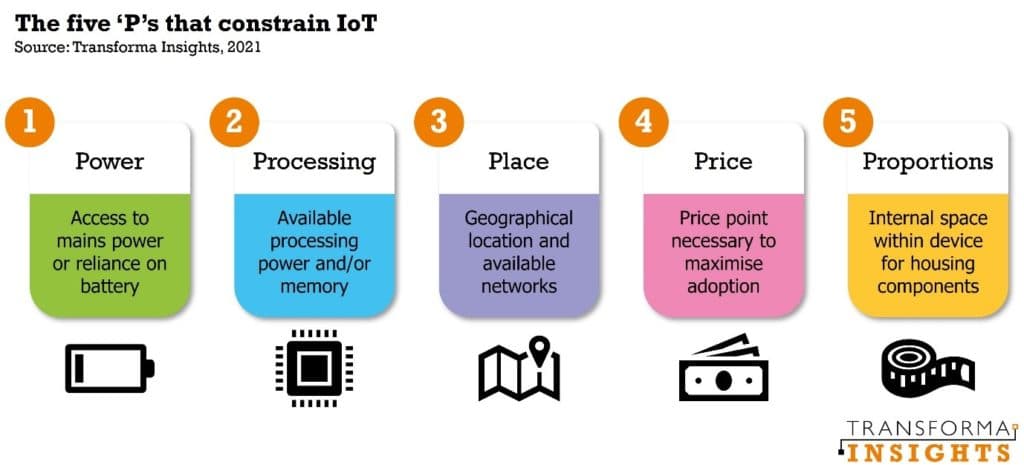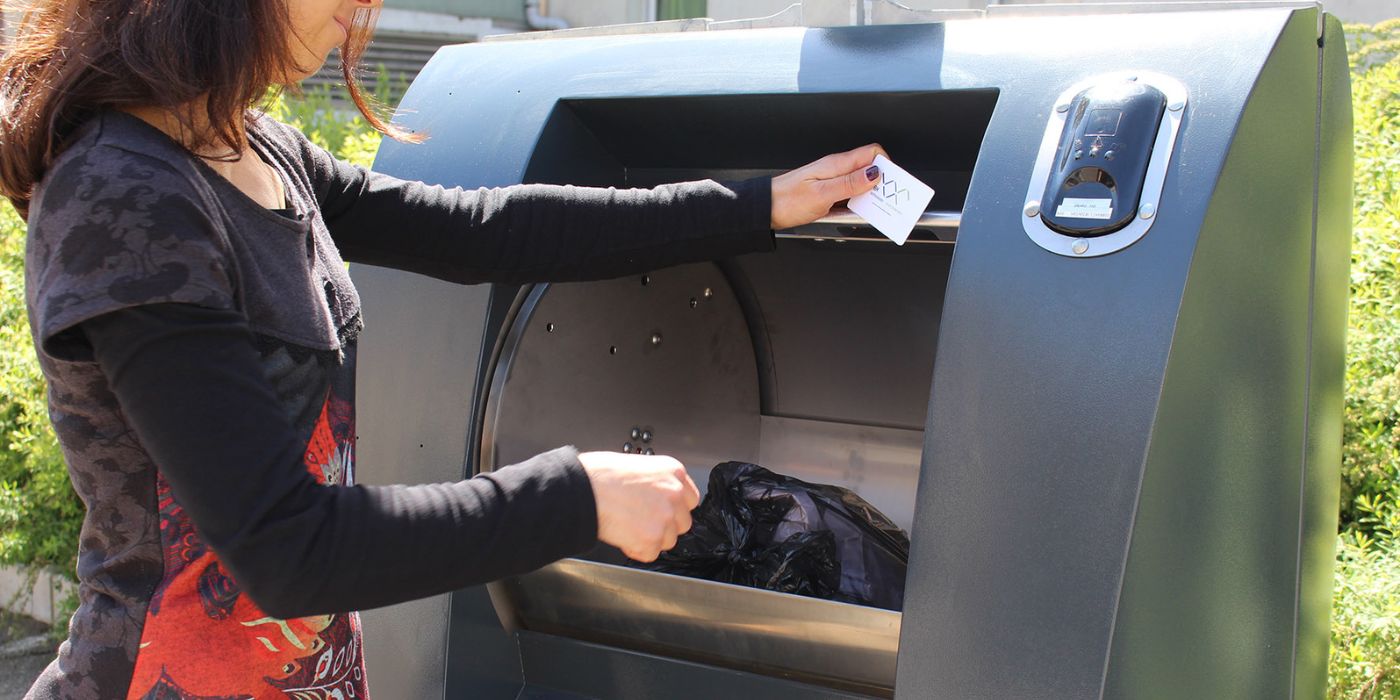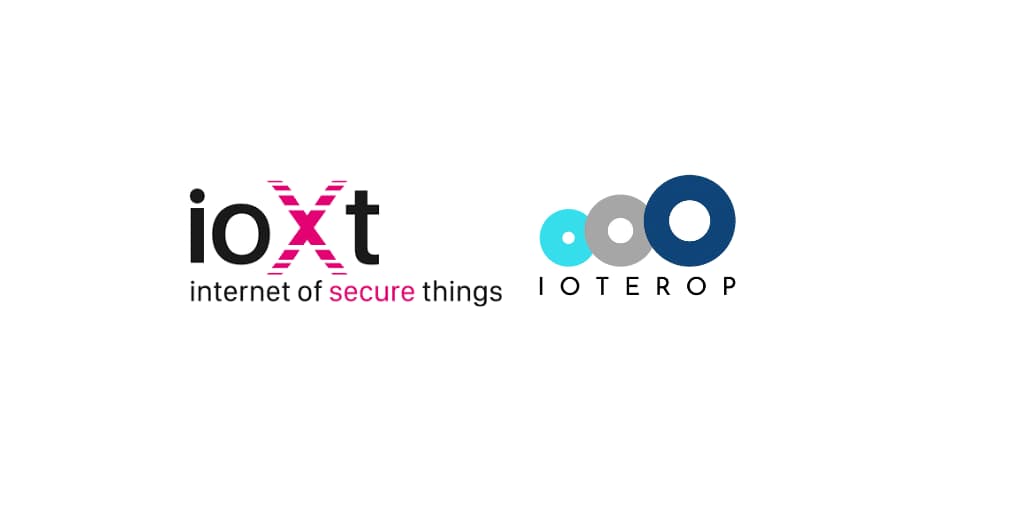The 5 ‘P’s that constrain IoT and how to use the ‘Thin IoT’ stack to overcome them
IoTerop is pleased to partner with Matt Hatton, Founding Partner at Transforma Insights to offer a fresh perspective on overcoming common IoT deployment challenges.
A recent Transforma Insights report ‘What is the ‘Thin IoT’ stack and why do I need it?’ explored the various technology elements that make up an IoT solution, from hardware to application. In this blogpost I examine the constraints that IoT developers have to work under and the consequent necessity for a ‘Thin IoT’ stack that is best able to address it, including discussion of the optimum technologies.
The 5 ‘P’s of IoT
To ensure that IoT is as widely adopted and as optimised as possible for deployment it must work within a set of limitations. We have identified five main categories, what we term the 5 ‘P’s of IoT: power, processing, place, price and proportions, as illustrated in the image below.

The five are:
- Power – Many current and anticipated IoT use cases involve highly distributed assets, many (if not most) of which will have no easy access to mains power. Therefore, much of IoT needs to run on battery power. This necessitates a strict approach to limiting power consumption on the device, e.g. using a low power access technology such as LoRaWAN or LTE-M. This has further knock-on effects, with lower power technologies typically having more limited bandwidth and requiring the use of less chatty protocols such as CoAP and MQTT-SN, and doing more processing on the device itself, requiring more edge computing processing.
- Processing – Here we consider the CPU and memory on the device, which can be a major element of the cost of the device. The ‘Price’ constraint (below) therefore means acting within strict parameters on how much processing and memory is used. Capabilities such as system on a chip (SoC) and chip on board (CoB) effectively do more at lower cost than alternatives. Similarly, it’s important to have a light embedded operating system such as Amazon FreeRTOS, RIOT, TinyOS or Zephyr, which require less memory and processing.
- Place – The geographical location will have a big impact on how an IoT solution will be architected. Geographically remote devices may be limited to only certain kinds of technologies (just satellite in extreme circumstances).
- Price – Inevitably IoT developers will want to build a solution as cheaply as possible, either improving margins or allowing for cheaper prices and therefore wider adoption.
- Proportions – Some IoT deployments have to work within strict limitations in terms of the size of the device. An industrial monitoring device can probably be of any size while a smart watch, in contrast, has a very strict set of dimensions it needs to keep to.
Not all of these limitations will affect each deployment. For instance, electricity smart meters will always have a ready supply of power. There are also trade offs to be made between them. Limitations to just satellite connectivity might necessitate more on-device processing, for instance. However, all IoT deployments face some or all of these constraints. But the technology world has come to the rescue with a set of capabilities that are much more designed for working within these constraints. Transforma Insights refers to them as the ‘Thin IoT’ stack.
What is the Thin IoT stack?
The ‘Thin IoT’ stack comprises all of the various elements of an IoT solution. We consider this to comprise five main layers: device hardware, device software, networking, middleware, and edge computing and machine learning. Under each of those headings there are optimum technologies for best addressing IoT. The chart below illustrates the five tiers of the Thin IoT stack.
 At each level there are either relatively mature or newly emerging technologies that are optimised for working in constrained environments. This includes hardware developments such as system-on-chip and chip-on-board, embedded operating systems such as TinyOS and RIOT, networking technologies such as MQTT-SN, CoAP, LPWA technologies like LTE-M and LoRa, low touch connectivity onboarding platforms such as that from 1NCE, and data processing techniques such as TinyML. The characteristics of each are discussed in depth in the report. In this blog post I will focus in on just two: Low Power Wide Area (LPWA) access technologies NB-IoT and LTE-M, and device management capabilities in the form of Lightweight M2M (LwM2M).
At each level there are either relatively mature or newly emerging technologies that are optimised for working in constrained environments. This includes hardware developments such as system-on-chip and chip-on-board, embedded operating systems such as TinyOS and RIOT, networking technologies such as MQTT-SN, CoAP, LPWA technologies like LTE-M and LoRa, low touch connectivity onboarding platforms such as that from 1NCE, and data processing techniques such as TinyML. The characteristics of each are discussed in depth in the report. In this blog post I will focus in on just two: Low Power Wide Area (LPWA) access technologies NB-IoT and LTE-M, and device management capabilities in the form of Lightweight M2M (LwM2M).
NB-IoT and LTE-M technologies, which are part of the 5G family of standards, have specific features to make them work well where power is constrained, i.e. typically working on battery power. These capabilities include Power Saving Mode (PSM) which allows the device to disconnect from the network for up to 14 days but not require a complex handshake when it is reactivated. They also allow for Extended Discontinuous Reception (eDRX), which allows devices that are active to minimise the time during which they are actively listening for incoming messages (up to several hours for NB-IoT). These capabilities provide a significant power-saving benefit, although obviously with the associated cost in terms of latency.
Device management (DM) platforms are a major middleware element. DM involves the provisioning, configuration, authentication, monitoring, control and updating of devices deployed in the field to ensure they are functioning correctly and securely. In the context of IoT, and due to the IoT device being connected, much of the device management is handled remotely over-the-air (OTA). The main DM standard relevant for Thin IoT is Lightweight M2M (LwM2M). It was developed by the Open Mobile Alliance (OMA), which previously developed the OMA-DM standard for phones. OMA reinvented the OMA-DM standard for IoT as LwM2M. It is built on CoAP with RESTful APIs for device management, exposing device management resources such as security, connectivity, location and firmware upgrades. LwM2M works well with eDRX and PSM by queueing messages for delivery when the device is connected. As a result it’s very good in conjunction with NB-IoT.
Few IoT deployments will use all of these technologies, or even need to consider all of the layers of the stack. But, their combined capabilities are certainly reducing the barriers to deploying IoT. Transforma Insights estimates that of the 27 billion IoT connections forecast for end 2030, over 90% of connections will make use of some of them. For more on IoT Forecasts, see our IoT Forecast Highlights page.
This article is a short summary of the findings of the report, which delves in much more detail into the optimum technologies, protocols and architectures for deploying IoT. For more information about Transforma Insights, please see our website transformainsights.com or contact us at enquiries@transformainsights.com. Follow us on Twitter: @transformatweet.


